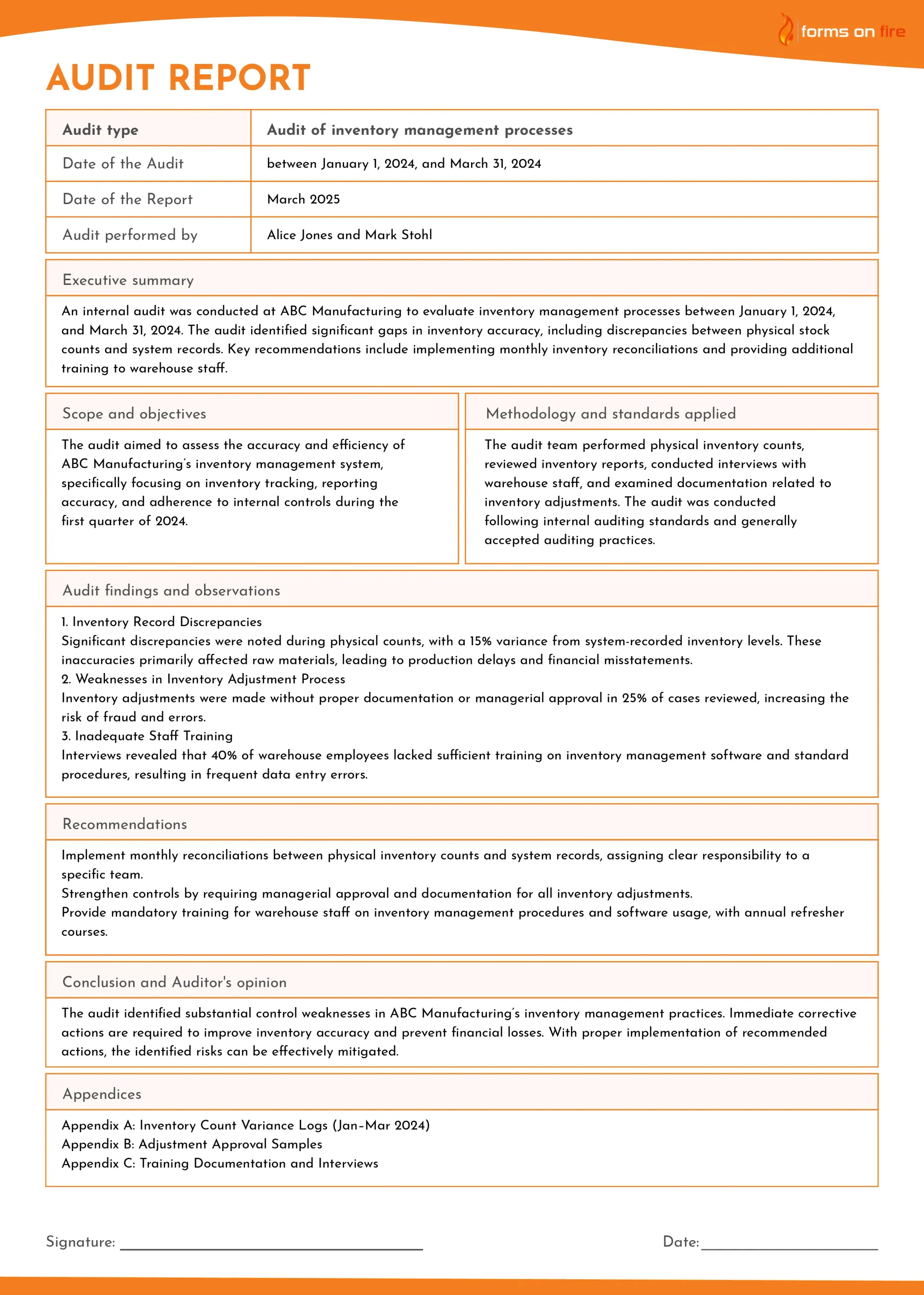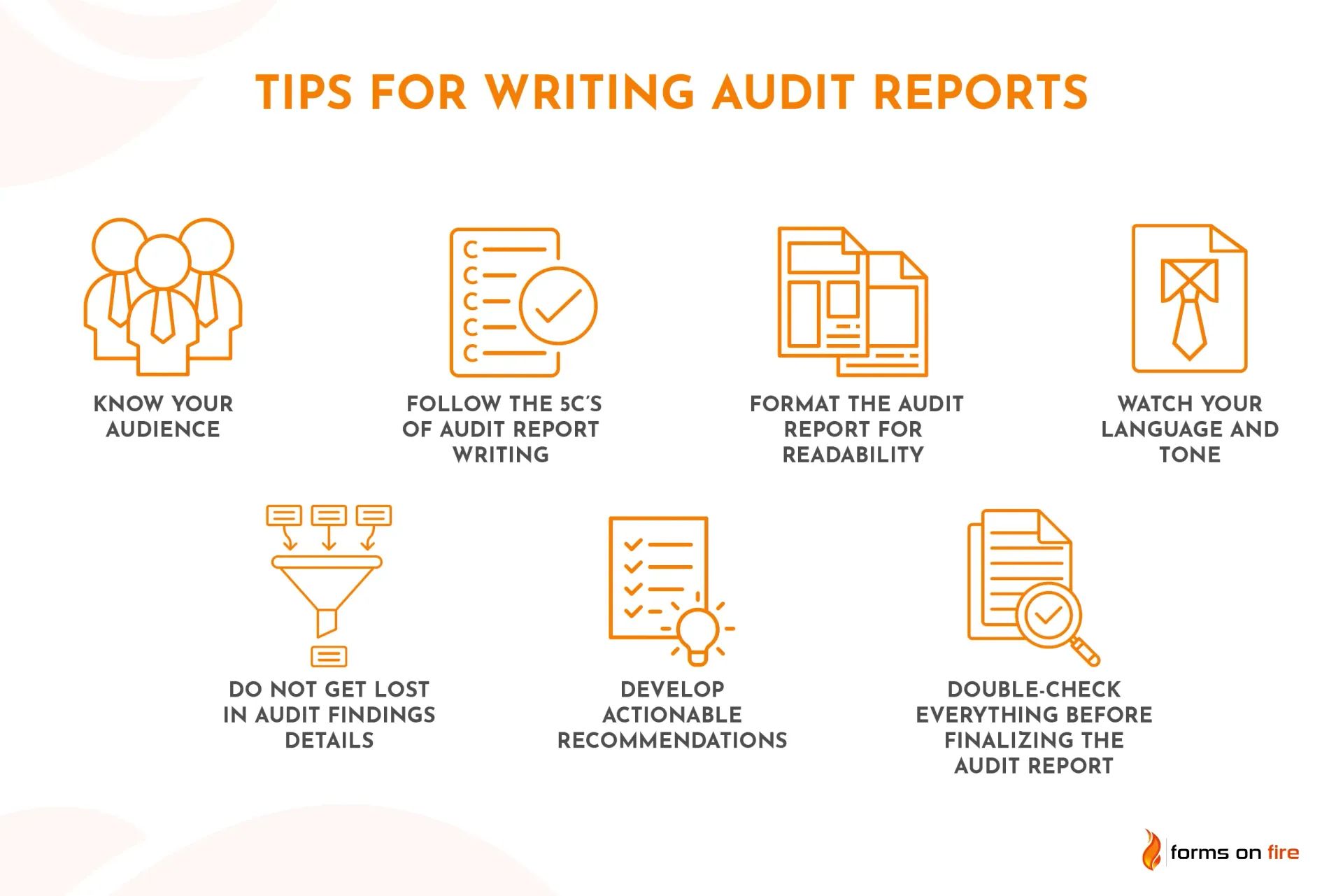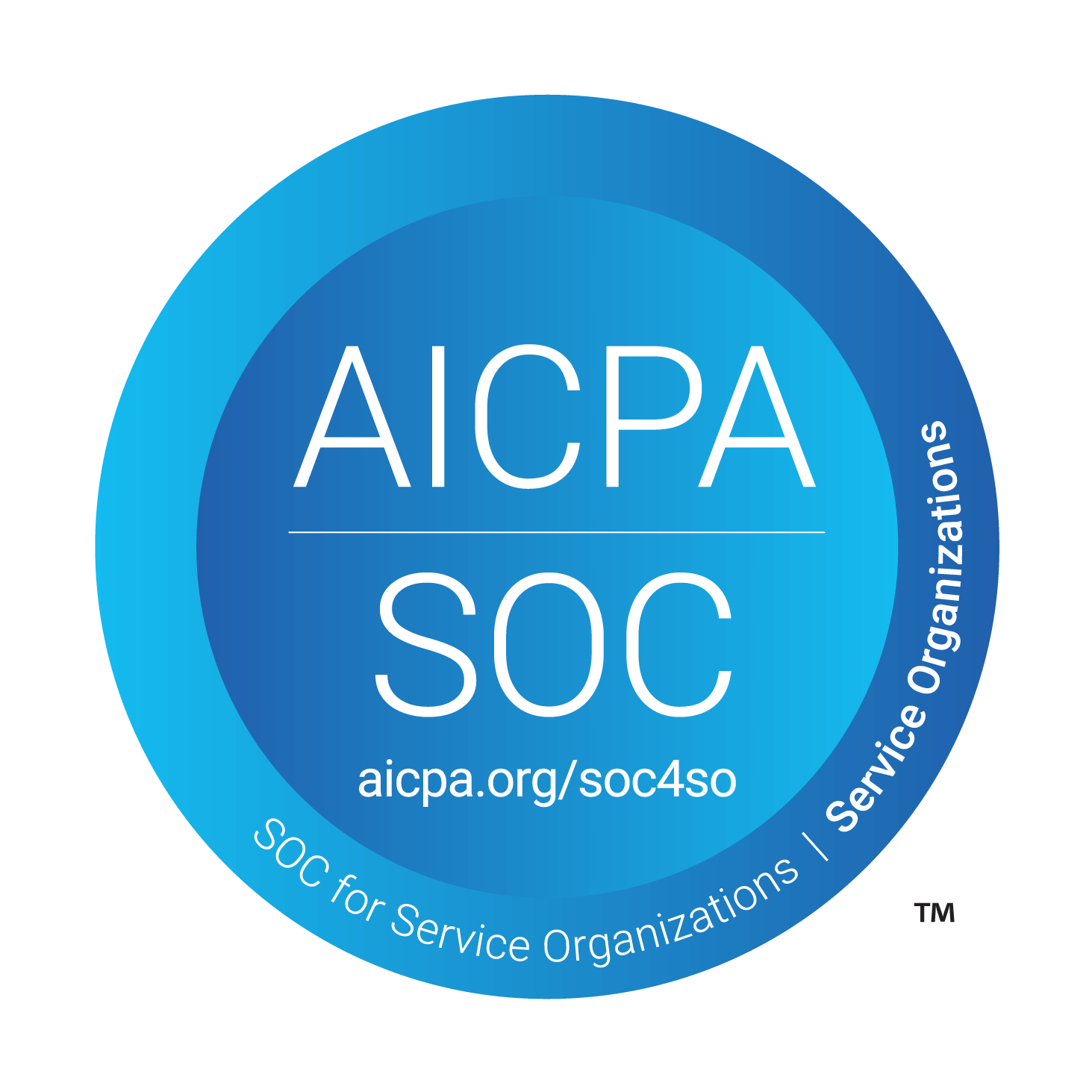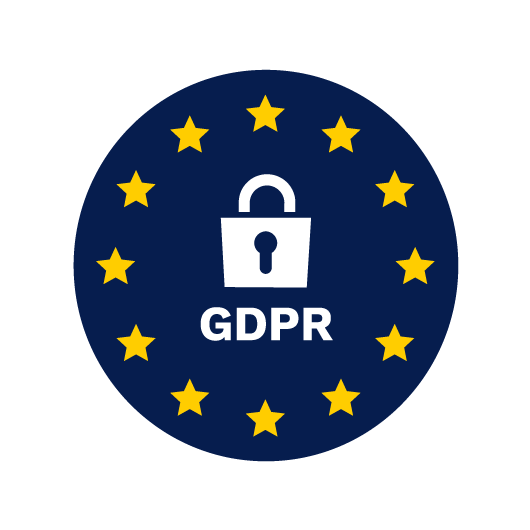How to Structure and Write an Audit Report
Writing a clear audit report isn't just about documenting your findings — it’s about helping your organization make better decisions. A well-structured audit report highlights key issues, offers actionable recommendations, and guides stakeholders toward improvement.
Yet, many auditors and managers struggle with reports that feel overly technical, unclear, or simply overwhelming.
In this article, we’ll explain what makes an audit report compelling. You’ll learn how to structure such a report, see practical examples, and get actionable tips to improve readability and impact.
We’ll also discuss common pitfalls auditors encounter and show you how leveraging modern technology — like the Forms On Fire platform — can simplify and streamline your audit reporting process.
Let’s start with the basics.
What is an audit report?
An audit report is an official document summarizing the findings of an audit. It informs stakeholders — such as company executives, board members, or regulators — about the audit's results, including any issues discovered and recommended actions for improvement.
Audits can vary greatly depending on their purpose, scope, and industry. Despite that, the structure of these reports often looks quite similar.
Typically, audit reports are written by auditors themselves — internal auditors for internal reports or external auditors for independent reviews. However, managers may also contribute to internal audit reports, especially when developing actionable recommendations or providing context around findings.
Items to include in an audit report
Organizations can perform many types of audits — EHS audit, safety audit, inventory audit, operational audit, financial audit, and so on.
Regardless of the type, every audit report should clearly communicate its findings and recommendations.
While specific formats may vary depending on your internal standards, most audit reports include the following sections:
- Executive summary: This brief overview summarizes the key audit findings, conclusions, and recommendations. It allows executives and busy readers to quickly grasp essential points without reading the entire document.
- Scope and objectives: Clearly defines what the audit covers and its main goals. It should outline specific areas reviewed, timeframe considered, departments involved, and any limitations or boundaries set for the audit.
- Methodology and standards applied: Describes the methods and techniques used during the audit, including references to auditing standards or regulations followed. This section demonstrates transparency and helps ensure the audit's credibility.
- Audit findings and observations: Provides detailed descriptions of issues identified during the audit, supported by evidence. It clearly distinguishes facts from interpretations or opinions, allowing readers to understand precisely what was found.
- Recommendations: Offers actionable steps that the organization can take to address the findings. Effective recommendations directly tie to audit findings and aim to improve processes, reduce risks, or strengthen controls.
- Conclusion and auditor’s opinion: Summarizes the audit's overall outcomes and provides the auditor's professional opinion on the state of the audited area. It’s concise yet informative, reflecting the broader implications of the findings.
- Appendices and supporting documentation (if applicable): Includes additional information such as data, charts, tables, or other documentation that supports audit findings but would interrupt the main report's flow if included directly.
An example of an audit report
Below is a simplified example of an audit report that could be written after assessing the accuracy and efficiency of an inventory management system at a facility called ABC Manufacturing.
How to write an audit report: tips and best practices
The following practical tips should help you craft compelling audit reports that drive meaningful actions.
1) Know your audience
Different readers have different priorities. Executives typically prefer high-level summaries that clearly highlight risks, opportunities, and overall impact. Managers, on the other hand, need actionable recommendations they can put into practice.
When preparing your audit report, ask yourself:
- Who will read this report?
- What do they care about most?
- What level of detail is appropriate for each group?
Tailor your audit report accordingly:
- Executives/Board members: Focus on concise summaries of key issues, risk exposure, overall compliance status, and strategic implications. In general, that is what the executive summary is for.
- Managers/Supervisors: Provide specific details, context, and realistic recommendations on addressing identified problems.
- Operational staff: If they’ll read portions of your report, ensure instructions are clear, direct, and actionable.
A report is rarely made just for a single group. Instead, you will have specific sections of the report that will be interesting to different stakeholders.
2) Follow the 5C’s of audit report writing
The 5C’s framework provides auditors and managers with a structured method for presenting findings and recommendations. It makes the audit report easier to follow and understand.
Here's how the 5C’s help standardize your issue-and-recommendation sections:
- Condition (What?): Establishes a consistent way to describe exactly what you found during the audit. It helps readers quickly understand the specific issue.
- Criteria (Standard): This ensures that you always clarify the benchmark or standard the audited area was supposed to meet. Clearly defined criteria help readers see gaps between actual conditions and expected standards.
- Cause (Why?): Encourages auditors to consistently investigate and articulate the root cause of each identified problem.
Consequence (So what?): Makes sure you always highlight why the issue matters, emphasizing risks or potential impacts. It ensures your audience immediately understands the significance and urgency of addressing each finding. - Corrective Action (What next?): Pushes auditors to offer clear, actionable, and relevant recommendations directly linked to their findings.
By adopting the 5C framework, your reports will communicate better what needs to be done, why it matters, and how to do it.
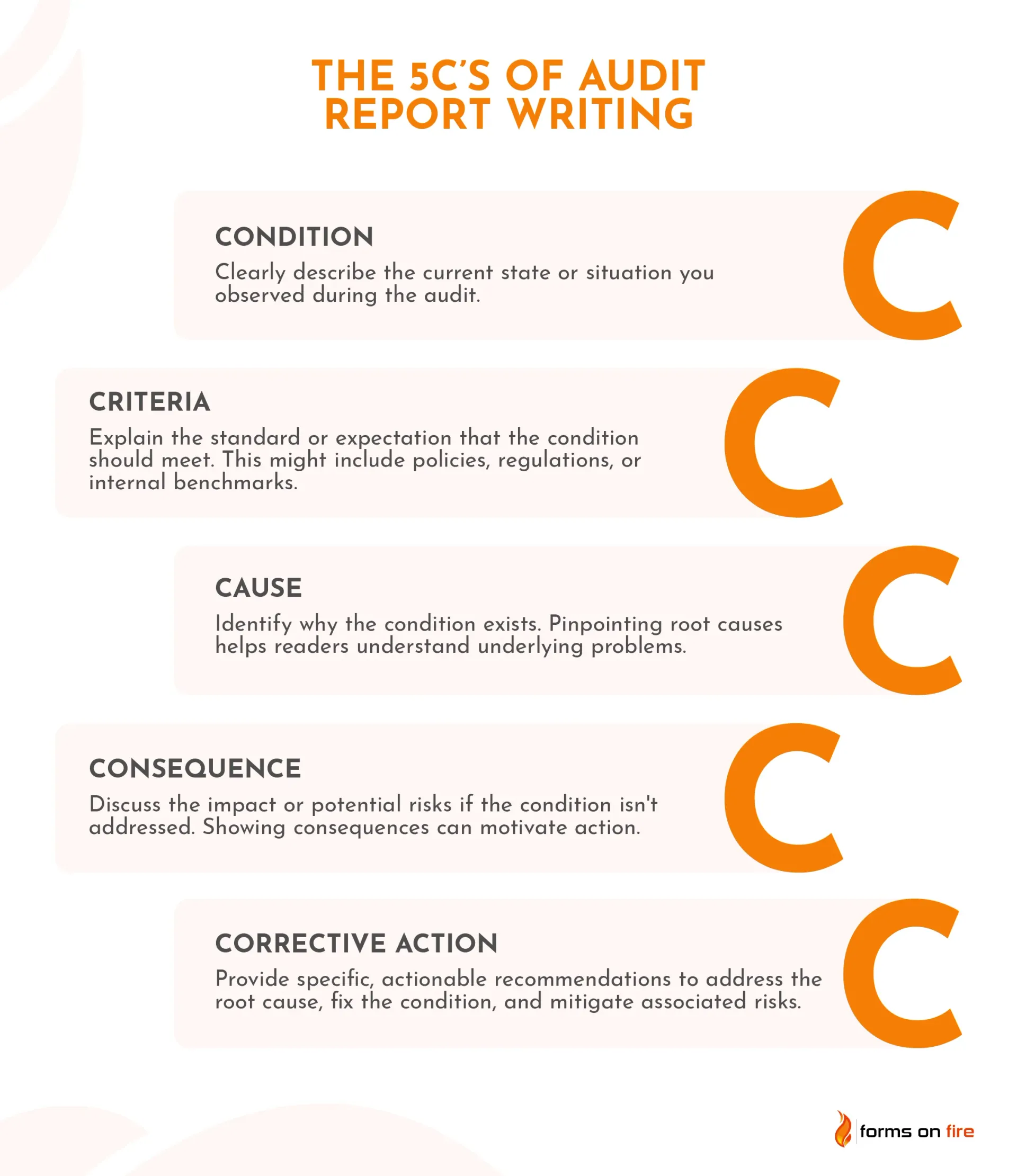
3) Format the audit report for readability
The audit report should be easy to scan so that readers can quickly find the sections that interest them. That’s why it is worth considering how you will organize and present information visually.
You do not have to do anything fancy. Concentrate on these simple things:
- Logical flow from findings to recommendations: Present your audit findings clearly, followed immediately by corresponding recommendations. Group related findings together to make your narrative easy to follow.
- Clearly defined sections and headings: Use descriptive headings and subheadings and visually separate different sections (some empty space will do) so readers can quickly locate key information.
- Effective use of bullet points, tables, and visuals: Break down complex information into concise bullet points or easy-to-understand tables. Include visuals, such as charts, graphs, or simple diagrams, to illustrate key points.
4) Watch your language and tone
The language and tone you use in your audit report impact how your findings and recommendations are going to be received. Try to maintain an objective, professional, and unbiased tone that focuses on the facts.
Here are practical guidelines to keep in mind:
- Be objective and factual: Separate facts from opinions. Present your findings based on evidence rather than assumptions or interpretations.
- Avoid vague or ambiguous language: Phrases like "several issues," "occasionally," or "many errors" create uncertainty. Instead, quantify and specify, such as "8 out of 20 transactions reviewed had errors."
- Minimize jargon and technical terms: Avoid overly technical or specialized language unless necessary. When technical language is required, briefly explain it or provide context so everyone can understand your point.
Some examples of effective phrasing:
❌Instead of: "There were numerous instances where guidelines weren't followed."
✅ Use: "Guidelines for invoice approval were not followed in 12 of 30 cases reviewed."
❌ Instead of: "It appears that employee training could be better."
✅ Use: "Employee training records indicate that 40% of the warehouse staff have not received updated safety training in the past year."
❌Instead of: "The storage area was messy and disorganized."
✅ Use: "Materials in the storage area were not properly labeled or organized, creating a risk of misplaced or damaged inventory."
❌Instead of: "Documentation was incomplete."
✅ Use: "Documentation reviewed was incomplete, with key forms missing signatures and dates, limiting traceability and accountability."
❌Instead of: "Employees seemed unclear on proper procedures."
✅ Use: "Employees interviewed could not consistently describe established safety procedures, indicating a gap in training and internal communication."
❌Instead of: "Equipment isn't being maintained properly."
✅ Use: "Regular preventive maintenance work for critical machinery has not been consistently performed on time."
5) Do not get lost in audit findings details
If you provide too much detail in your report, the audience may lose focus, miss critical points, or misunderstand priorities. If there is not enough detail, stakeholders might either overestimate the importance of the finding or fail to understand the urgency and required action.
To strike the right balance:
- Present findings factually and objectively: Clearly state your observations without excessive elaboration. Stick to relevant facts that support your conclusions and recommendations.
- Provide necessary context: Numbers or facts presented alone can be misleading. Always include context explaining why a finding matters and its implications for the organization.
- Avoid excessive detail: While evidence and documentation are essential, save extensive detail for appendices or supporting documents rather than cluttering your main report.
It can be tricky to hit the right level of detail the first time you write the report. After seeing how it was received and getting feedback, you’ll know what to do for subsequent reports.
6) Develop actionable recommendations
As we mentioned earlier, your recommendations should be practical and tied directly to identified issues.
For example, suppose your audit finding shows that construction workers did not consistently use required PPE. In that case, your recommendation should specifically address this issue: "Implement mandatory PPE training sessions and highlight the importance of PPE in pre-job briefings. Enforce daily supervisory checks for a certain period to ensure compliance."
Moreover, your recommendations should align with the organization's strategic goals and current risk environment. Recommendations that directly support company objectives are more likely to be prioritized and implemented effectively.
For instance, if improving workplace safety is one of your organization's strategic goals, your recommendation might be: "Establish a safety incentive program rewarding departments with the highest compliance rates, directly supporting the organization's safety-first culture."
This way, everyone will know both what and why specific actions must be taken.
7) Double-check everything before finalizing the audit report
Review your draft report for factual accuracy, completeness, and logical flow. Verify all numbers, dates, and findings against your original audit documentation to ensure consistency and accuracy. Confirm your report is coherent, moving logically from the identified issues to the recommended actions.
Next, ensure your audit methodology and documentation are consistently applied throughout the report. Clearly state the standards and processes used, and verify that you've followed established auditing procedures.
Having a colleague or supervisor conduct a peer review of your report is also beneficial. A fresh perspective often identifies gaps, unclear language, or overlooked errors.
Finally, double-check that your audit report complies with relevant auditing standards, company policies, and regulatory requirements. If needed, make the final adjustments.
With this, your audit report should be accurate, actionable, and credible — a powerful tool for driving positive organizational change.
Leverage technology to streamline audit reporting
If you are performing audits on a regular basis — which you should — do yourself a favor and digitize the process. This can be done on a couple of different levels.
First, you can use our simple mobile form builder to create digital checklists and data collection forms to simplify the auditing process itself. You can capture videos and images with your mobile device and collect digital signatures — both online and offline. This is a great way to standardize the process, be efficient, and keep all the documentation and evidence in one place.
Then, the Forms On Fire platform can generate automatic reports for those forms and checklists you’ve used, which you can easily include in your final audit report.
If you want to take this a step further, you can build the whole audit report template inside Forms On Fire. You can add different branding elements and other details to personalize it. Then, for every following report, you can just change the input data and generate the report with a single click.
Help your team simplify the audit reporting process and reduce administrative waste. Book a quick demo to see how Forms On Fire can help!
Company
Contact
Platform
Resources
Use Cases
Industries

